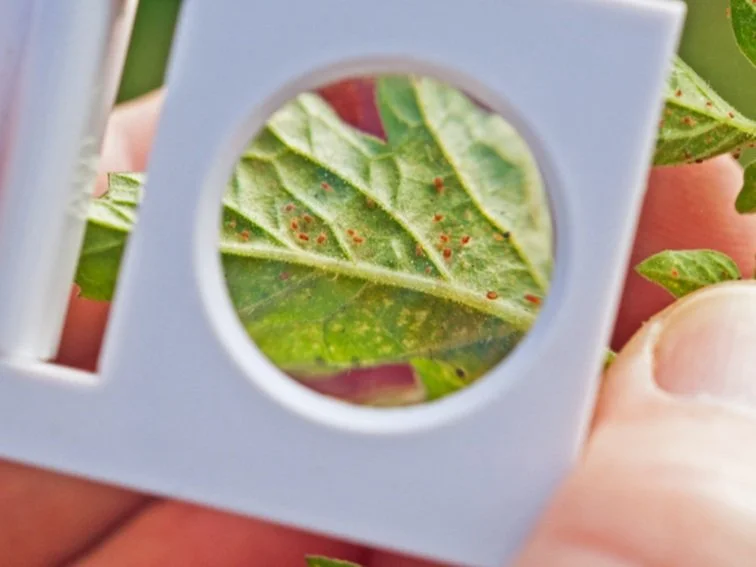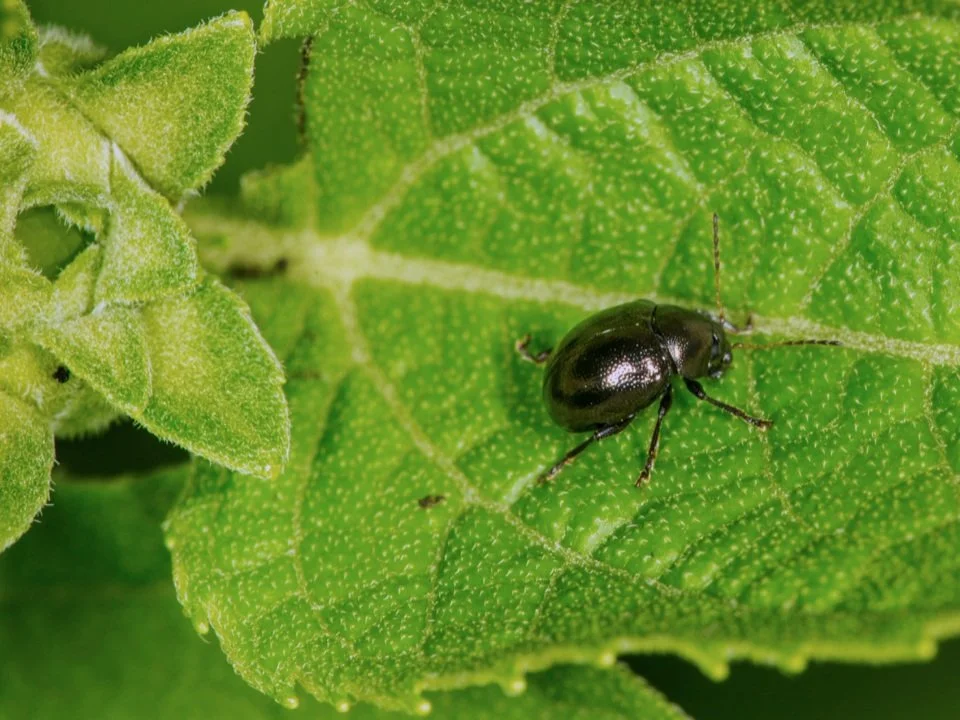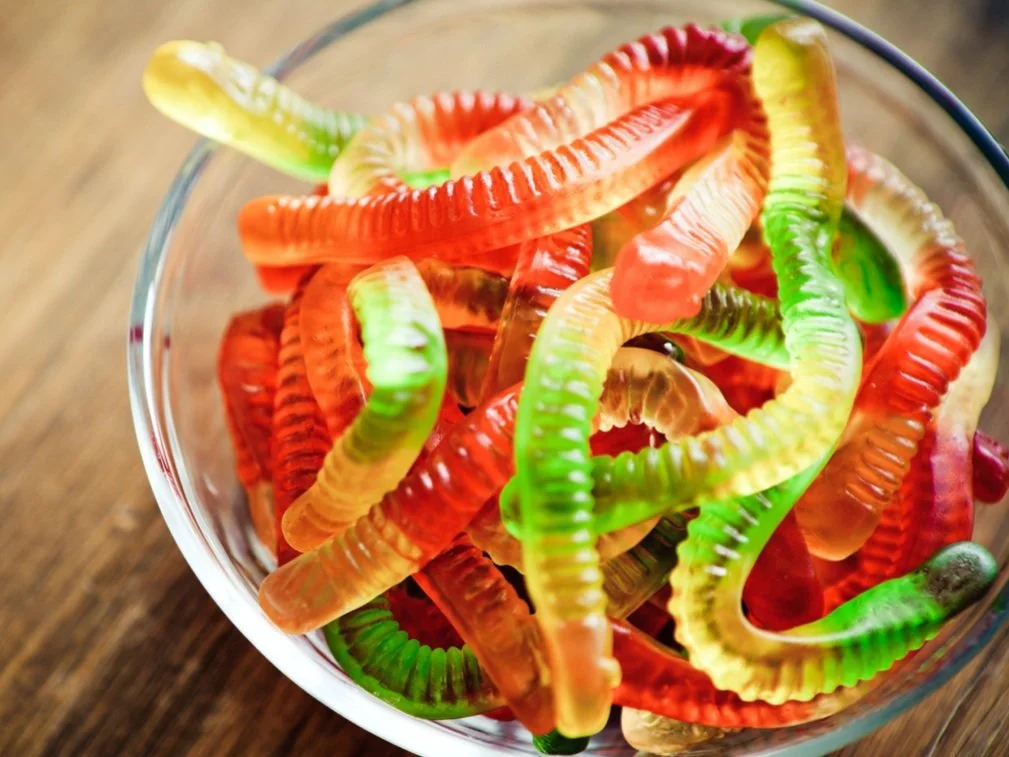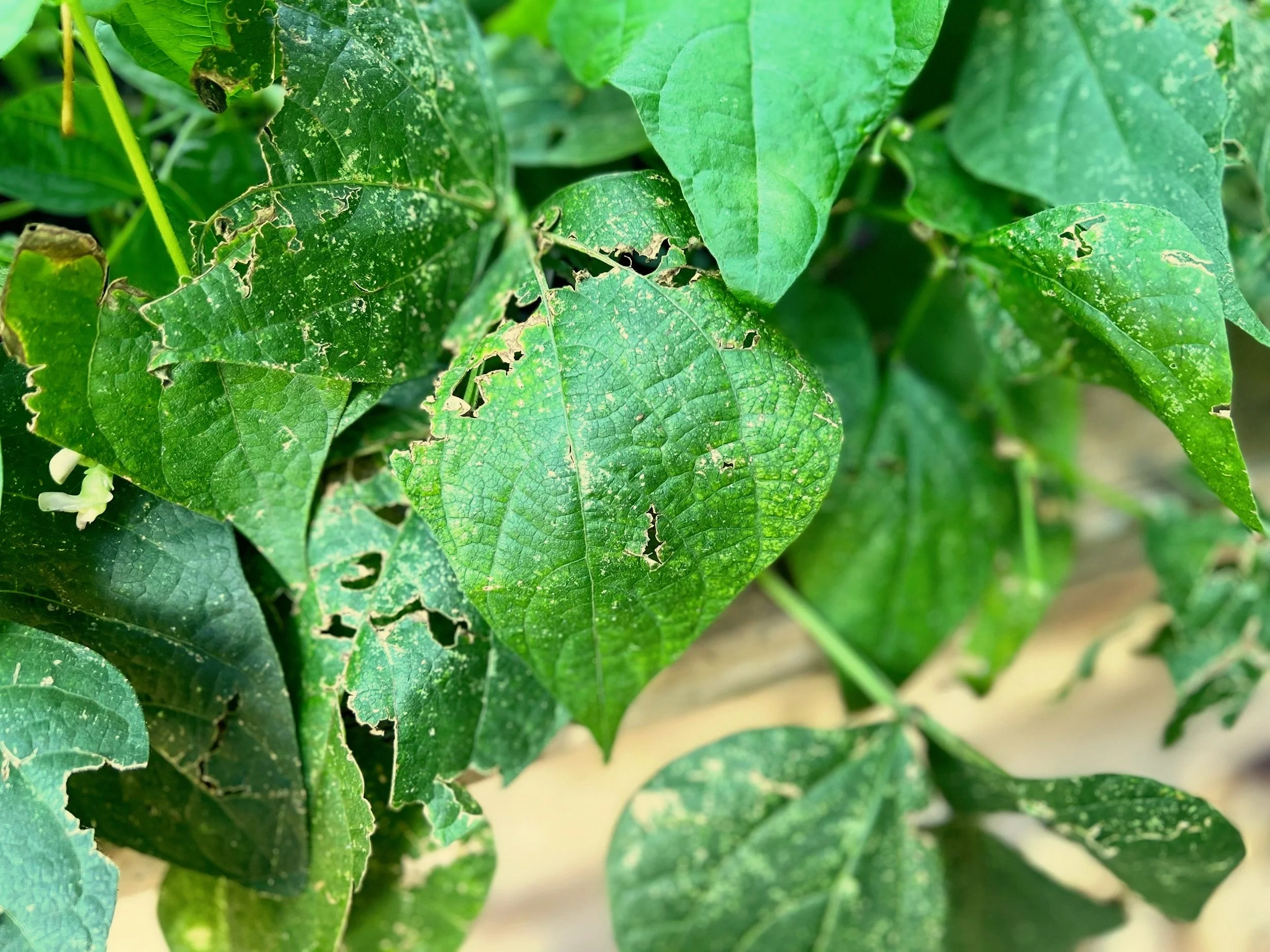Help! What’s Eating My Veggies?
Honestly, here in the South it could be just about anything! Kitchen garden pests are abundant in this region and can do loads of damage - either by piercing and sucking or by chewing.
In fact, there are more pests in the Southeast than in just about any other gardening area in the United States. Go figure! In this post, we’ll take a closer look at the top kitchen garden offenders and offer some suggestions for how to control the little buggers.
Aphids
Aphids are small, soft-bodied insects that are about 1/8 inch long. They range in color from yellow to pale green to black. Aphids tend to show up early in the spring, but can hang around throughout the growing season. If present, you’ll likely see them in clusters under the leaves of your plants or on the stems at the growing points.
Unfortunately, Aphids tend to feed on just about any variety of vegetables including broccoli, cabbage, cauliflower, squash, cucumber, beans, peas, potatoes, tomatoes, lettuce, turnips, spinach and other kitchen garden crops. Aphids are piercing/sucking insects and will drain a plant’s juices leaving the plant’s leaves wrinkled, yellow and brown. These pests also can spread plant viruses from diseased plants to healthy ones.
The key to controlling Aphids is to catch them early. Start inspecting your plants in early spring. If you find an infestation, you might be able to wash them away using a forceful stream of water from a garden hose. By the time July rolls around, however, Aphids are more likely to be carrying plant viruses and will require treatment using a recommended insecticide.
Spider Mites
Spider Mites are super tiny - you can hardly see them. They can range in color from red and orange to yellow or green. While Spider Mites actually aren’t insects - they are closely related to ticks (which are part of the arachnid family) - they cause damage by sucking out plant juices from the underside of a plant’s leaves. You can tell you have Spider Mites if you see your plants covered in fine webs that look like spider webs.
Spider Mites love hot, dry weather and really like to feed on beans, corn, tomatoes and eggplant. As the Spider Mites suck out a plant’s juices, the plant’s leaves become blotched with white or pale yellow/brown spots. Eventually the leaves will turn a pale, sickly yellow/brown and drop from the plant.
Spider Mites can overwinter in your kitchen garden, so removal of weeds and plant debris is super important. Keeping your kitchen garden soil adequately moist also will help deter a Spider Mite infestation. However, if you find Spider Mites in your kitchen garden, it’s likely that a recommended miticide will need to be applied every 3 to 4 days until the Spider Mites have been extinguished.
Southern Green Stink Bug
The Southern Green Stink Bug is flat, shaped like a shield and about 5/8 inch long. It’s also a bright green color and gives off a really foul odor if you crush it. Stink Bugs like to feed on beans, okra, tomatoes, melons, squash, cucumbers and sweet corn.
Stink Bugs are insects with piercing and sucking mouthparts. They will withdraw plant juices from the plant’s leaves and fruit while injecting a toxic saliva. Damage to leaves shows up as yellow spots with a halo. Damage to fruit varies with the type of vegetable involved. Tomato damage, for example, shows up as white spots or white-yellow spots while sweet corn damage shows up as spirally twisted leaves.
Keeping your kitchen garden free of weeds may help with reducing Stink Bugs. However, due to the fact that there are so many weed hosts, if you find Stink Bugs in your kitchen garden immediately apply a recommended insecticide.
Flea Beetle
Flea Beetles are very small, shiny insects that are black or striped. They also are jumpers when they are disturbed. Flea Beetles mostly attack only 1 plant or the closely related varieties within a single plant family. Some of the most destructive species in this area are the potato flea beetle, the spinach flea beetle, the striped flea beetle and the sweet potato flea beetle. Other crops that can be severely injured by the Flea Beetle are tomatoes, peppers, eggplant and cucumbers.
The damage caused by Flea Beetles looks like very small, rounded or irregular holes similar to those resulting from using a hole punch. Leaves can have a shot-hole appearance. And, if there’s an abundance of Flea Beetles, foliage may be so badly eaten that it can no longer function. Flea Beetles can spread disease from 1 plant to another, and the small holes caused by Flea Beetles can act as entry points for bacteria and fungi.
Removing weeds that act as hosts for Flea Beetles may reduce the population. Using an insecticide around the perimeter of your kitchen garden also may reduce or prevent the ability of the Flea Beetle to enter the garden. However, if Flea Beetles or damage from Flea Beetles is seen, recommended insecticides should be applied in order to avoid further and more serious damage.
Corn Earworm a/k/a Tomato Fruitworm
I know, I know. This is NOT a photo of a Corn Earworm. But I just couldn’t include a picture - these worms are just too awful looking. So - it’s a photo of gummy worms instead - LOL. If you really want to see what this worm looks like - here’s a link to a photo of a Corn Earworm published by the Purdue Univeristy Extension.
The Corn Earworm larvae (called the Tomato Fruitworm when found on tomato plants) can be 1 3/4 inches long. It can vary in color from light-green to pink to brown or almost black, with alternating light and dark stripes and a yellow head. Its legs are dark and its skin is covered with short black hairs (which can only be seen with a magnifying lens). Yuck, right?
Corn Earworms feed on a wide variety of vegetable plants including beans, peas, sweet corn, okra, cabbage, eggplant, tomatoes and peppers. Corn Earworms chew holes in bean pods, peas, okra, eggplant and peppers, and chew buds and leaves in the whorl on sweet corn, later feeding on the silks and kernels. Tomato Fruitworms chew holes in leaves, blossoms and fruit.
To reduce the chance of infestation, plant as soon as weather permits. Early maturing vegetable plants may escape any Corn Earworms that make an appearance later in the growing season. If any larvae are discovered, a recommended insecticide should be used. Also the damaged tips of corn ears may be cut off and discarded.
Prevention & Management
The best way to control pests in your kitchen garden is by prevention - which can be extremely challenging. But there are steps you can take to manage any pests that may appear and maximize success:
Select a good kitchen garden site and prepare it well. Pests can be located in weeds, grasses or soil that previously existed on the site you’ve chosen.
Choose vegetable varieties that are best suited for your location. Pay attention to soil pH and the application of nutrients, fertilizers, lime and water. Healthy plants are more resistant to pest damage.
Rotate your crops. From one year to the next, plant your kitchen garden beds with varieties from different plant families. Planting the same variety in the same location year after year can cause a build-up of pests and diseases that live in the soil. Changing locations of varieties within the kitchen garden can disrupt a pest’s food source or host.
Plant resistant varieties. Choose vegetable varieties that are resistant to pests in your area. This doesn’t necessarily mean that these particular varieties won’t fall prey to the pest you’re trying to avoid, but they likely will show less damage when compared to other varieties.
Keep your kitchen garden clean and sanitary. Inspect your plants prior to planting to be sure they are pest-free. Remove plant debris and weeds after harvesting to reduce the chance that pests will mature or overwinter in your kitchen garden beds. And follow proper plant spacing to lessen areas where pests are likely to hide.
Apply chemicals correctly. Both preventative and curative treatments are very dependent upon the pest involved so choose wisely. Even organic treatments can harm beneficial insects if not used properly. And remember, you can start out with the least toxic treatments like insecticidal soaps and neem oil, then work your way up to more stronger chemical controls if necessary.
Sign up for the Kitchenairy Gardens email list for more kitchen and garden tips and advice. And be sure to follow me on Instagram and Facebook (@kitchenairygardens) and on Pinterest (@kissmygardenish).







